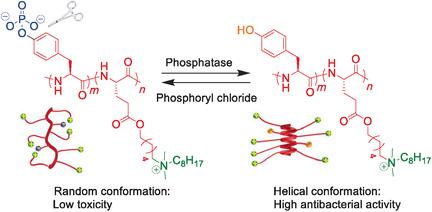当前位置:
X-MOL 学术
›
Angew. Chem. Int. Ed.
›
论文详情
Our official English website, www.x-mol.net, welcomes your feedback! (Note: you will need to create a separate account there.)
Bacteria‐Assisted Activation of Antimicrobial Polypeptides by a Random‐Coil to Helix Transition
Angewandte Chemie International Edition ( IF 16.1 ) Pub Date : 2017-07-28 , DOI: 10.1002/anie.201706071 Menghua Xiong 1 , Zhiyuan Han 1 , Ziyuan Song 1 , Jin Yu 1 , Hanze Ying 1 , Lichen Yin 2 , Jianjun Cheng 1, 2
Angewandte Chemie International Edition ( IF 16.1 ) Pub Date : 2017-07-28 , DOI: 10.1002/anie.201706071 Menghua Xiong 1 , Zhiyuan Han 1 , Ziyuan Song 1 , Jin Yu 1 , Hanze Ying 1 , Lichen Yin 2 , Jianjun Cheng 1, 2
Affiliation

|
The application of antimicrobial peptides (AMPs) is largely hindered by their non‐specific toxicity against mammalian cells, which is usually associated with helical structure, hydrophobicity, and charge density. A random coil‐to‐helix transition mechanism has now been introduced into the design of AMPs, minimizing the toxicity against mammalian cells while maintaining high antimicrobial activity. By incorporating anionic phosphorylated tyrosine into the cationic polypeptide, the helical structure of AMPs was distorted owing to the side‐chain charge interaction. Together with the decreased charge density, the AMPs exhibited inhibited toxicity against mammalian cells. At the infectious site, the AMPs can be activated by bacterial phosphatase to restore the helical structure, thus contributing to strong membrane disruptive capability and potent antimicrobial activity. This bacteria‐activated system is an effective strategy to enhance the therapeutic selectivity of AMPs.
中文翻译:

细菌辅助的抗菌肽通过随机螺旋向螺旋转变的活化
抗菌肽(AMPs)对哺乳动物细胞的非特异性毒性在很大程度上阻碍了抗菌肽的应用,这通常与螺旋结构,疏水性和电荷密度有关。现在,在AMP的设计中引入了随机的盘绕到螺旋过渡机制,从而在保持高抗菌活性的同时,最大程度地降低了对哺乳动物细胞的毒性。通过将阴离子磷酸化酪氨酸掺入阳离子多肽,由于侧链电荷相互作用,AMP的螺旋结构发生了扭曲。与降低的电荷密度一起,AMP对哺乳动物细胞表现出抑制的毒性。在感染部位,AMPs可以被细菌磷酸酶激活以恢复螺旋结构,因此有助于强大的膜破坏能力和有效的抗菌活性。这种细菌激活的系统是提高AMPs治疗选择性的有效策略。
更新日期:2017-07-28
中文翻译:

细菌辅助的抗菌肽通过随机螺旋向螺旋转变的活化
抗菌肽(AMPs)对哺乳动物细胞的非特异性毒性在很大程度上阻碍了抗菌肽的应用,这通常与螺旋结构,疏水性和电荷密度有关。现在,在AMP的设计中引入了随机的盘绕到螺旋过渡机制,从而在保持高抗菌活性的同时,最大程度地降低了对哺乳动物细胞的毒性。通过将阴离子磷酸化酪氨酸掺入阳离子多肽,由于侧链电荷相互作用,AMP的螺旋结构发生了扭曲。与降低的电荷密度一起,AMP对哺乳动物细胞表现出抑制的毒性。在感染部位,AMPs可以被细菌磷酸酶激活以恢复螺旋结构,因此有助于强大的膜破坏能力和有效的抗菌活性。这种细菌激活的系统是提高AMPs治疗选择性的有效策略。














































 京公网安备 11010802027423号
京公网安备 11010802027423号